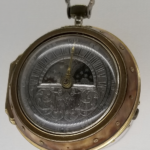
The majority of the historical collection is kept in two rooms lined with cases along all walls and more cases in the center of the room. The amount of work is a bit overwhelming, especially given that most of the pieces offer little in the way of a description and vague origin and date. The work is presented on its own merit, shown alongside hundreds of other pieces that are also competing for appreciation.

Those with a background in jewelry making, or a knowledge of art history, will have a little more context in which to place the items on display. There is large representation from some eras where archaeological interest and a cultural importance for jewelry intersect. So among many, many pieces of beautiful byzantine gold work, there were but a few examples of Celtic or northern European origin. And perhaps, since this is a European museum, there is nearly nothing included from early American cultures.




The two rooms of historical works include examples up to the beginning of the 20th century. A third room is dedicated to a large collection of watches from the 17th through 19th centuries and includes examples from some notable early watchmakers.
Next, read about the Schmuckmuseum’s the contemporary jewelry collection (Schmuckmuseum, part three).

